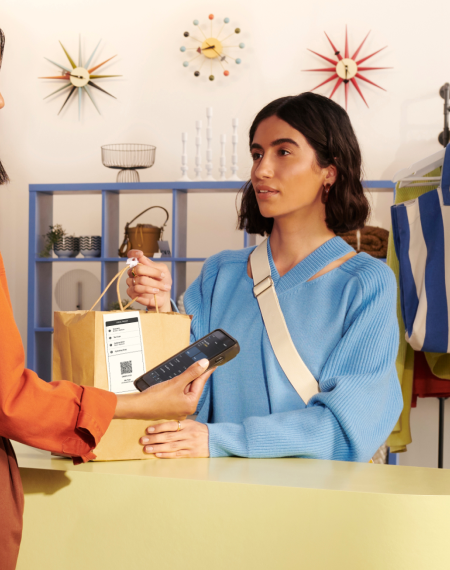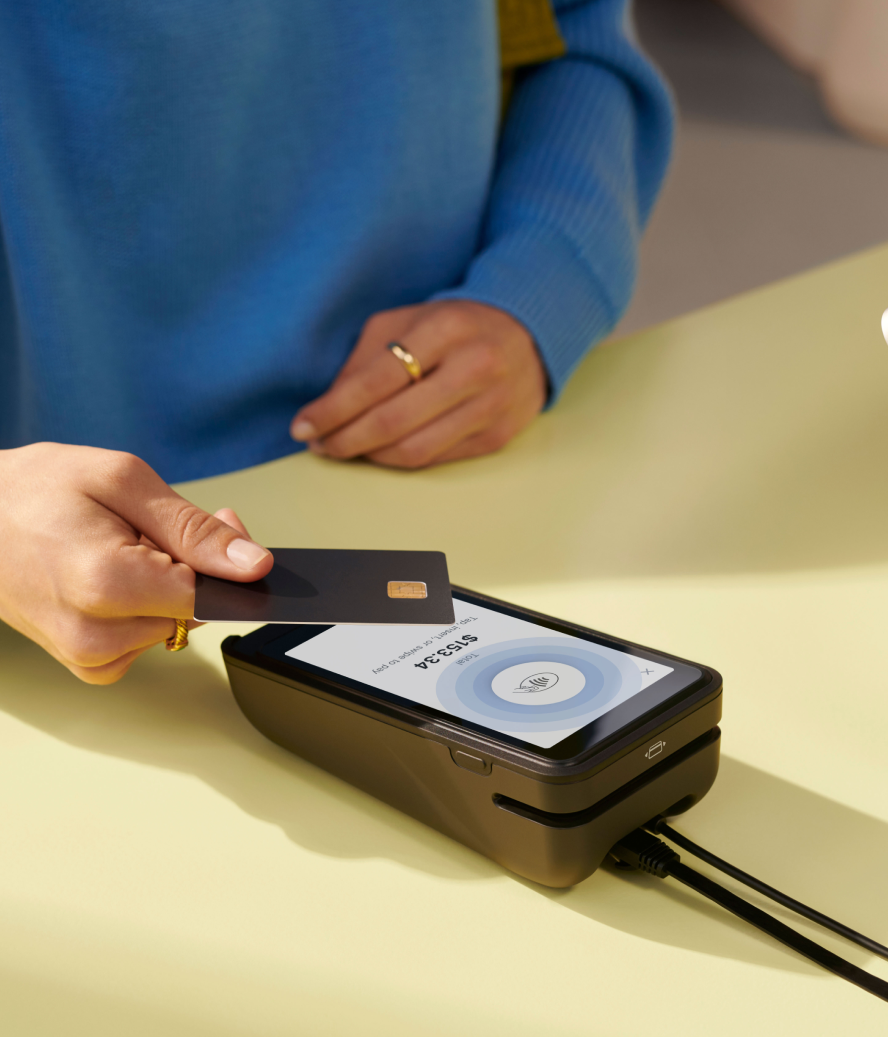As the name suggests, “buy online, return in-store” (BORIS) is a retail policy that lets shoppers make an online purchase, get the product shipped to their home, and if they’re unsatisfied with the purchase, return it in-store as an alternative to shipping it back.
According to the National Retail Federation, for every $1 billion in sales, retailers incur $166 million in returns. That’s 16.6% of all revenue, making returns a significant part of running a retail business. Online shopping has significantly contributed to high return rates; in 2020, online returns doubled.
BORIS is gaining popularity as a convenient way for shoppers to make returns, and as a way for omnichannel retailers to take advantage of their brick-and-mortar outposts.
Considering offering BORIS at your shop? Keep reading to learn why you should consider a buy online, return in-store policy and how to implement it successfully.
What is buy online return in-store (BORIS)?
“‘Buy online, return in store' is an omnichannel strategy that allows retailers to take advantage of complementarities between their online and brick-and-mortar businesses,” says Kate Ashley, Associate Teaching Professor in the Supply Chain and Information Management Group at Northeastern University's D’Amore-McKim School of Business.
With BORIS, when customers make purchases online, they have the option of returning products to the shop instead of making a return via the mail. This opportunity saves customers from packaging the item back up, requesting and printing a shipping label (or possibly paying shipping costs), going to the post office, and waiting for the retailer to process the return and issue a refund.
A policy like BORIS creates value for customers by giving them more options—in this case, many shoppers love the convenience of shopping online, but may perceive mail-in returns to be a hassle. Offering the ability to return items in store is a way for retailers with a brick-and-mortar presence to differentiate themselves from online-only competitors, and may drive incremental sales from customers who would be hesitant to buy online without an easy return option.
💡 PRO TIP: With Shopify POS, you can accept returns or exchanges for purchases made online or at another store location and your inventory will be updated instantly–no manual reconciliation required.
Benefits of a buy online, return in-store policy
With BORIS you can retain sales, reduce return shipping costs, boost store traffic, and make shopping more convenient for your customers. Here’s a closer look at the benefits of a buy online, return in-store policy.
Retain revenue
Many retailers big and small offer to cover return shipping to stay competitive. However, these expenses can cut into profit margins. When customers return online orders in-store, they save the retailer the time and costs associated with making a return, which helps your business retain revenue.
To further mitigate revenue loss, consider offering store credit on returns instead of refunds to the original form of payment.
Boost store foot traffic
When online shoppers enter your store to make a return, they may end up impulse buying something new that they found while making the return.
Even if BORIS customers don’t end up making a new purchase, just having more people in your shop could make it seem more popular and attract passersby who will end up buying something.
Increased customer convenience and loyalty
BORIS is convenient for customers because they don’t have to worry about their package getting lost in the mail. Your business can process returns and issue refunds immediately when products are brought in-store, which customers appreciate.
By offering such a convenient service to shoppers, you boost customer loyalty and therefore revenue.
Studies show that just a 5% increase in customer loyalty can increase sales by up to 95%.
Disadvantages of a buy online, return in-store policy
While BORIS comes with great perks for your business and its customers, there are also a few downsides to consider. BORIS only works well if your store has multiple, convenient locations. The program can lead to store congestion and place more demands on your staff. Here’s a closer look.
Works best with convenient locations
If your business has a wide reach online and ships to customers all over the country or world, but has a limited number of shops in locations that aren’t close to your online customers, then BORIS isn’t a viable option for these customers and can lead to customer dissatisfaction.
Customers who don’t live near a store may feel frustrated that they can’t take advantage of free in-store returns and have to pay for return shipping or go through the hassle of doing a mail-in return and wait weeks for a refund.
Store congestion
When customers make returns in-store, they increase foot traffic in your shop. While boosting store traffic is beneficial during slower times of the day or the year, it can create congestion and longer lines during busy seasons (like the holidays) or during the weekend shopping rush.
Longer lines create a poor customer experience, which leads to frustration.
Store congestion is also problematic during the COVID-19 pandemic. Some customers may steer clear of entering your shop if it’s too crowded.
You can mitigate these concerns by implementing line busting measures and introducing and enforcing store capacity limits to aid social distancing.
More demands on staff
When customers bring returns in-store, staff members need to process more returns. In addition to helping customers, BORIS could also put a strain on staff.
How BORIS works and how to implement it
Interested in introducing a buy online, return in-store policy? Here are the steps to take to make it work for your business.
1. Create a process
“Reverse logistics (including the management of customer returns) is a big challenge for many retailers, and an area that is receiving more attention lately as companies seek to reduce waste while still meeting customer needs and service expectations,” Professor Kate Ashley says.
A retailer that offers BORIS needs to have a clear process for handling merchandise that is returned to a store, especially if the assortment offered online differs from brick-and-mortar offerings.
Ashley continues, “For this reason, BORIS is often used in combination with other omnichannel policies such as buy online, ship from store (allowing the use of store inventory to fulfill online orders).”
As you create your internal process for BORIS, consider the logistics of any other shipping and return systems you have in place, like BOPIS or curbside pickup:
- Should customers go to the main checkout point to make a return, or will there be a designated returns spot?
- Who will be in charge of processing returns?
- Where will returned items be stored? Will they be put on the shelves of your shop, or returned to a central warehouse for redistribution?
- Will you offer store credit for BORIS returns, or a full refund to the original payment method?
- What will customers need to show to conduct a return: proof of payment, an ID, their original form of payment, and/or something else?
2. Provide instructions
After creating an internal process for BORIS, make your policy and instructions available to customers. The better you explain the process, the less admin work your team will have to do, like answering customer questions.
First, add a section about how BORIS works to your website’s returns policy page. Then, if you’ll only accept in-store returns for certain items, mark which items can be returned in-store on their corresponding product pages.
Finally, include information about BORIS in order confirmation emails and on packing slips.
3. Accept returns in-store for online purchases
Now that you’ve laid the groundwork for a buy online, return in-store system, it’s time to spring into action. When customers approach your return spot (or conduct a return anywhere in the store through a mobile POS), have them show a proof of purchase (email, packing slip, etc.). Then have your staff inspect the item before processing the return.
If the item is in good shape and within the returns time window, provide a refund, process an exchange, or give store credit for the return.
4. Integrate returns into your inventory
The final step is to integrate returned items into your inventory. If you have a centralized inventory system and carry the same inventory online as in-store, you can simply repackage the item and put it back on the shelf. If your inventory is decentralized, place returned items in a bin in your shop until you can bring it back into your warehouse or other location.
Tips for running a buy online return in-store program
Now that you know the basics of making BORIS work for your business, here are several expert tips that will help streamline your process.
Create a dedicated returns area
If you have the space for it, create a designated area for returns. Doing so will ensure that customers don’t have to wait in a long checkout line if they want to make a return, which helps reduce congestion.
And when there’s a separate line for returns and for purchases, it’s easier for customers making returns to jump into the checkout line if something catches their eye.
Use an omnichannel inventory tool
Using an omnichannel inventory tool – one that tracks inventory both from your ecommerce platform and all your brick-and-mortar locations – makes managing returns easier. When in-store and ecommerce inventory isn’t siloed, you can accurately know what you have available through all channels.
And if you offer “buy online, send from store,” the return you process can immediately be made available for purchase online.
Leverage customer data
Use customer data to improve the shopping and returns process, thereby boosting customer satisfaction and sales. Use your point-of-sale (POS) system’s reporting features to collect and analyze customer data. Look for trends in how customers make purchases (online versus in-store) and where they make returns.
Consider sending surveys to customers who take advantage of BORIS to find out how the process went for them. Use that data to improve the returns process or your documentation to reduce questions.
Examples of BORIS in action
Here are some retailers who currently offer in-store returns for purchases made online. Check out their policies and customer interfaces for inspiration.
Abercrombie & Fitch
Customers who make online purchases with American fashion brand Abercrombie & Fitch can make returns in two ways. They can either pay a $7 shipping fee to make returns in the mail, or they can return merchandise for free in one of the company’s many stores.
Target
Big-box retailer Target has a dedicated returns area in its stores where customers can return products they bought in-store or online. Customers simply need to present a receipt or their payment method to take advantage of BORIS. With many locations all over the United States, Target makes BORIS very accessible.
Amazon
While Amazon is slowly rolling out a brick-and-mortar presence, it uses subsidiary Whole Foods as brick-and-mortar outposts where online shoppers can return almost anything they buy on Amazon.com.
Leverage BORIS for your store
A buy online, return in-store policy gives you a competitive edge, makes shopping convenient for customers, and lets you take advantage of an omnichannel retail strategy. By creating a smooth internal process and explicitly letting customers know how it works, you can make in-store returns smooth for your team and customers.
Read more
- How To Integrate Your Point of Sale With Shopify
- 5 Strategies to Future Proof Your Brick-and-Mortar Store
- Retail Apps to Power Your Omnichannel Experience
- How Retail Store Owners Can Optimize Their Mobile Presence
- Lightspeed vs Shopify POS: The Best of All Lightspeed Alternatives
- How to Create a Cohesive Customer Experience For Online and Offline Sales
- What is Try Before You Buy? (+ 7 Brands Doing It Right)





